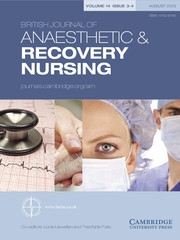Crossref Citations
This article has been cited by the following publications. This list is generated based on data provided by Crossref.
Smedley, Pat
2012.
BARNA National Audit on Staffing in the Post Anaesthetic Care Unit – Results.
British Journal of Anaesthetic and Recovery Nursing,
Vol. 13,
Issue. 3-4,
p.
48.



